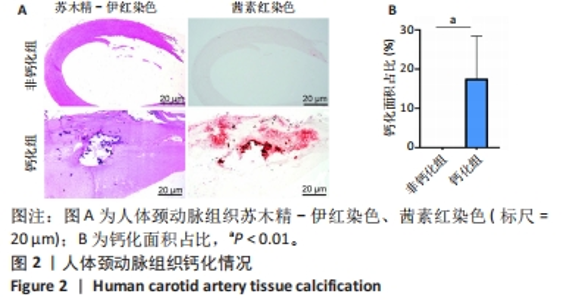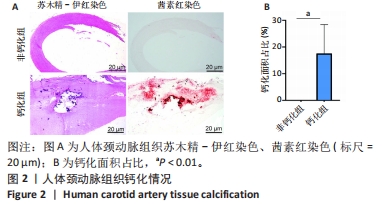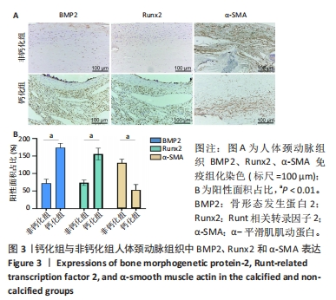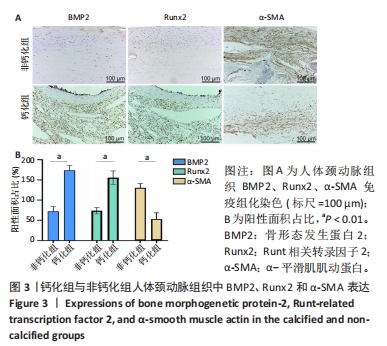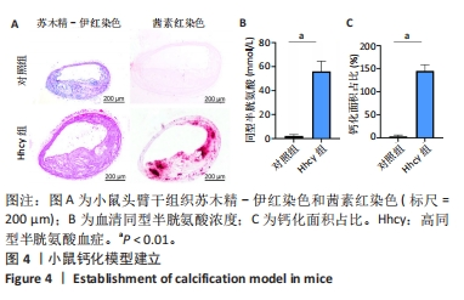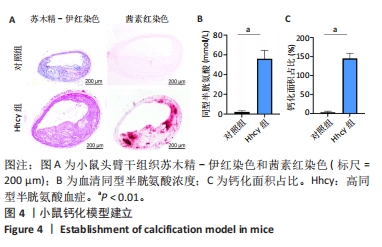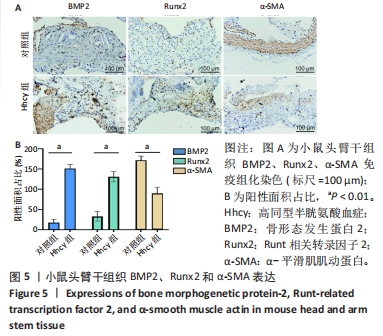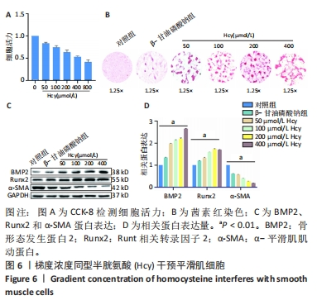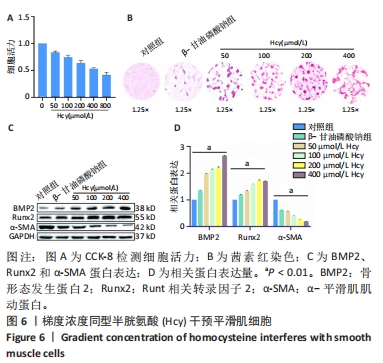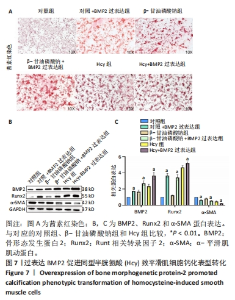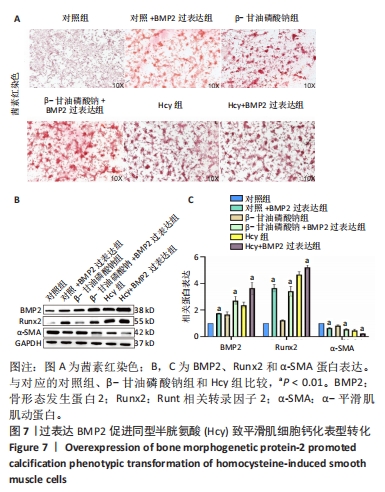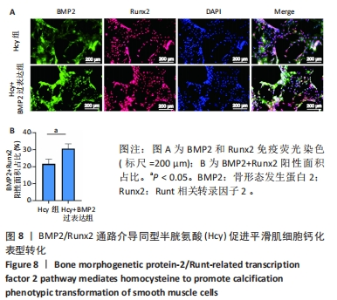Chinese Journal of Tissue Engineering Research ›› 2024, Vol. 28 ›› Issue (25): 4027-4033.doi: 10.12307/2024.183
Previous Articles Next Articles
Bone morphogenetic protein-2 mediated homocysteine promotes vascular calcification
Pei Jiansheng1, Yang Wenjuan2, He Jing1, Yan Ru2, Huang Hui2, Jia Shaobin2
- 1School of Clinical Medicine, Ningxia Medical University, Yinchuan 750004, Ningxia Hui Autonomous Region, China; 2Heart Center, General Hospital of Ningxia Medical University, Yinchuan 750004, Ningxia Hui Autonomous Region, China
-
Received:2023-06-12Accepted:2023-07-17Online:2024-09-08Published:2023-11-24 -
Contact:Jia Shaobin, Doctoral supervisor, Professor, Chief physician, Heart Center, General Hospital of Ningxia Medical University, Yinchuan 750004, Ningxia Hui Autonomous Region, China Huang Hui, Doctoral candidate, Associate professor, Chief physician, Heart Center, General Hospital of Ningxia Medical University, Yinchuan 750004, Ningxia Hui Autonomous Region, China -
About author:Pei Jiansheng, Master candidate, School of Clinical Medicine, Ningxia Medical University, Yinchuan 750004, Ningxia Hui Autonomous Region, China -
Supported by:National Natural Science Foundation of China, No. 8206020164 (to HH)
CLC Number:
Cite this article
Pei Jiansheng, Yang Wenjuan, He Jing, Yan Ru, Huang Hui, Jia Shaobin. Bone morphogenetic protein-2 mediated homocysteine promotes vascular calcification[J]. Chinese Journal of Tissue Engineering Research, 2024, 28(25): 4027-4033.
share this article
Add to citation manager EndNote|Reference Manager|ProCite|BibTeX|RefWorks
| [1] ALLISON MA, HSI S, WASSEL CL, et al. Calcified atherosclerosis in different vascular beds and the risk of mortality. Arterioscler Thromb Vasc Biol. 2012;32(1):140-146. [2] LEE SJ, LEE IK, JEON JH. Vascular Calcification-New Insights Into Its Mechanism. Int J Mol Sci. 2020;21(8):2685. [3] QUAGLINO D, BORALDI F, LOFARO FD. The biology of vascular calcification. Int Rev Cell Mol Biol. 2020;354:261-353. [4] AZZINI E, RUGGERI S, POLITO A. Homocysteine: Its Possible Emerging Role in At-Risk Population Groups. Int J Mol Sci. 2020;21(4):1421. [5] MORETTI R, CARUSO P. The Controversial Role of Homocysteine in Neurology: From Labs to Clinical Practice. Int J Mol Sci. 2019;20(1):231. [6] RENNENBERG RJ, SCHURGERS LJ, KROON AA, et al. Arterial calcifications. J Cell Mol Med. 2010;14(9):2203-2210. [7] YANG P, TRONCONE L, AUGUR ZM, et al. The role of bone morphogenetic protein signaling in vascular calcification. Bone. 2020; 141:115542. [8] ZHU L, ZHANG N, YAN R, et al. Hyperhomocysteinemia induces vascular calcification by activating the transcription factor RUNX2 via Krüppel-like factor 4 up-regulation in mice. J Biol Chem. 2019;294(51):19465-19474. [9] 代庆刚. mTOR/Raptor-S6K1信号通路通过Runx2调控小鼠成骨分化及骨发育[D].上海:上海交通大学,2016. [10] 黄辉,张爱华,陈靖,等.血管钙化研究进展和临床实践的共识与争议[J].生理学报,2022,74(6):859-884. [11] 蔡云峰.老年冠心病患者血清脂蛋白A-1、胱抑素C、同型半胱氨酸水平与冠状动脉粥样硬化的相关性分析[J].中国卫生检验杂志, 2023,33(4):479-481,486. [12] VILLA-BELLOSTA R. Vascular Calcification: Key Roles of Phosphate and Pyrophosphate. Int J Mol Sci. 2021;22(24):13536. [13] WILCKEN DE, WILCKEN B. The pathogenesis of coronary artery disease. A possible role for methionine metabolism. J Clin Invest. 1976;57(4): 1079-1082. [14] 范驰,马珊珊,张薇,等.血清Hcy HbA1c及APN与急性脑梗死患者认知功能障碍的相关性分析[J].河北医学,2023,29(1):147-153. [15] 李峰,王颖,王雪,等.应激与同型半胱氨酸诱导认知功能障碍作用机制的研究进展[J].军事医学,2022,46(11):867-871. [16] 李娜,杨爽,林卫红.糖尿病肾病患者同型半胱氨酸水平与颈动脉粥样硬化关系的研究[J].中风与神经疾病杂志,2022,39(8):731-735. [17] MUZUROVIĆ E, KRALJEVIĆ I, SOLAK M, et al. Homocysteine and diabetes: Role in macrovascular and microvascular complications. J Diabetes Complications. 2021;35(3):107834. [18] XIE W, SHAN Y, WU Z, et al. Herpud1 deficiency alleviates homocysteine-induced aortic valve calcification. Cell Biol Toxicol. 2023. doi: 10.1007/s10565-023-09794-w. [19] 梁英权,段亚君,韩际宏.血管钙化分子机制研究进展[J].中国动脉硬化杂志,2020,28(11):921-929. [20] BROZOVICH FV, NICHOLSON CJ, DEGEN CV, et al. Mechanisms of Vascular Smooth Muscle Contraction and the Basis for Pharmacologic Treatment of Smooth Muscle Disorders. Pharmacol Rev. 2016;68(2): 476-532. [21] HO CY, SHANAHAN CM. Medial Arterial Calcification: An Overlooked Player in Peripheral Arterial Disease. Arterioscler Thromb Vasc Biol. 2016;36(8):1475-1482. [22] STANFORD W, THOMPSON BH. Imaging of coronary artery calcification. Its importance in assessing atherosclerotic disease. Radiol Clin North Am. 1999;37(2):257-272. [23] KARMIN O, SIOW YL. Metabolic Imbalance of Homocysteine and Hydrogen Sulfide in Kidney Disease. Curr Med Chem. 2018;25(3): 367-377. [24] 丁浩,曹娟.高磷诱导血管平滑肌细胞钙化的信号通路研究进展[J].中国中西医结合肾病杂志,2020,21(7):650-653. [25] LANZER P, BOEHM M, SORRIBAS V, et al. Medial vascular calcification revisited: review and perspectives. Eur Heart J. 2014;35(23): 1515-1525. [26] MA WQ, SUN XJ, ZHU Y, et al. Metformin attenuates hyperlipidaemia-associated vascular calcification through anti-ferroptotic effects. Free Radic Biol Med. 2021;165:229-242. [27] YANG W, ZOU B, HOU Y, et al. Extracellular vesicles in vascular calcification. Clin Chim Acta. 2019;499:118-122. [28] ZHANG F, LI J, GU C, et al. MiR-140-5p upregulation suppressed β-glycerophosphate-induced vascular smooth muscle cell calcification via targeting TLR4. Immunopharmacol Immunotoxicol. 2022;44(3): 295-305. [29] TIAN L, WANG Y, ZHANG R. Galectin-3 induces vascular smooth muscle cells calcification via AMPK/TXNIP pathway. Aging (Albany NY). 2022;14(12):5086-5096. [30] TAO Y, GENG Y, DANG W, et al. Mechanism of Endoplasmic Reticulum Stress Pathway in the Osteogenic Phenotypic Transformation of Aortic Valve Interstitial Cells. Front Endocrinol (Lausanne). 2022;13:856331. [31] SULISTYOWATI E, HSU JH, LEE SJ, et al. Potential Actions of Baicalein for Preventing Vascular Calcification of Smooth Muscle Cells In Vitro and In Vivo. Int J Mol Sci. 2022;23(10):5673. [32] SHI C, TAN J, LU J, et al. MicroRNA-17-5p Promotes Vascular Calcification by Targeting ANKH. Curr Neurovasc Res. 2022;19(1):108-116. [33] JIANG Y, JI W, ZHU J, et al. Upregulation of miR-664a-3p Ameliorates Calcific Aortic Valve Disease by Inhibiting the BMP2 Signaling Pathway. Dis Markers. 2022;2022:2074356. [34] HAO N, ZHOU Z, ZHANG F, et al. Interleukin-29 Accelerates Vascular Calcification via JAK2/STAT3/BMP2 Signaling. J Am Heart Assoc. 2023; 12(1):e027222. [35] QIN CM, WEI X, GONG CP, et al. Expression of BMP2/Smad1/Runx2 Signal Pathway in Renal Artery of Rat with Vascular Calcification. Sichuan Da Xue Xue Bao Yi Xue Ban. 2016;47(2):180-183. [36] CHEN Z, DING W, DUAN P, et al. HWJMSC-derived extracellular vesicles ameliorate IL-1β-induced chondrocyte injury through regulation of the BMP2/RUNX2 axis via up-regulation TFRC. Cell Signal. 2023;105:110604. [37] LEE SH, KIM M, PARK MH. Diphlorethohydroxycamalol isolated from Ishige okamurae prevents H2O2-induced oxidative damage via BMP2/Runx2 signaling in osteoblastic MC3T3-E1 cells. Fitoterapia. 2021;152:104921. [38] LIN Y, SUN Z. Klotho deficiency-induced arterial calcification involves osteoblastic transition of VSMCs and activation of BMP signaling. J Cell Physiol. 2022;237(1):720-729. [39] LIN X, LI F, XU F, et al. Aberration methylation of miR-34b was involved in regulating vascular calcification by targeting Notch1. Aging (Albany NY). 2019;11(10):3182-3197. [40] TANAKA U, KAJIOKA S, FINOTI LS, et al. Decitabine Inhibits Bone Resorption in Periodontitis by Upregulating Anti-Inflammatory Cytokines and Suppressing Osteoclastogenesis. Biomedicines. 2021; 9(2):199. [41] CHEN R, QIU H, TONG Y, et al. MiRNA-19a-3p alleviates the progression of osteoporosis by targeting HDAC4 to promote the osteogenic differentiation of hMSCs. Biochem Biophys Res Commun. 2019;516(3):666-672. |
| [1] | Shen Jiangyong, He Xi, Tang Yuting, Wang Jianjun, Liu Jinyi, Chen Yuanyuan, Wang Xinyi, Liu Tong, Sun Haoyuan. RAS-selective lethal small molecule 3 inhibits the fibrosis of pathological scar fibroblasts [J]. Chinese Journal of Tissue Engineering Research, 2024, 28(8): 1168-1173. |
| [2] | Sheng Siqi, Xie Lin, Zhao Xiangyu, Jiang Yideng, Wu Kai, Xiong Jiantuan, Yang Anning, Hao Yinju, Jiao Yun. Involvement of miR-144-3p in Cbs+/- mouse hepatocyte autophagy induced by high-methionine diet [J]. Chinese Journal of Tissue Engineering Research, 2024, 28(8): 1289-1294. |
| [3] | Ma Lingju, Wang Lexin, Chi Hongyang, Zhang Jingwen, Peng Hongjian, Gao Chunlan, Jiang Yideng, Huang Hui, Yang Li, Ma Shengchao. Role of METTL3 in homocysteine-induced autophagy in mouse islet beta cells [J]. Chinese Journal of Tissue Engineering Research, 2024, 28(26): 4221-4225. |
| [4] | Ma Zhanhua, Yan Xu, Jiang Yan, Cao Zhengming, Wang Yongkui, Li Dongzhe, Yang Tengyue, Jin Yikai, Fu Su, Zhang Chunlin. Primary cilia/intraflagellar transport mediates mechanics-responsive signaling pathway and promotes osteogenic differentiation of bone marrow stromal stem cells [J]. Chinese Journal of Tissue Engineering Research, 2024, 28(25): 3937-3941. |
| [5] | Kuang Yuanjun, Yu Sumei, Zhong Yingyi, Zhang Xuhong, Ma Shengchao, Yang Anning, Hao Yinju, Xiong Jiantuan, Jiao Yun, Jiang Yideng. Effect of cyclic RNA hsa-circ-0001360 on homocysteine-induced apoptosis of human umbilical vein endothelial cells [J]. Chinese Journal of Tissue Engineering Research, 2024, 28(25): 4060-4064. |
| [6] | Qi Ming, Wang Lei, Zhang Zhen. CXCL5 participates in carotid plaque formation by inducing vascular calcification [J]. Chinese Journal of Tissue Engineering Research, 2024, 28(2): 186-192. |
| [7] | Wang Buyu, Zhang Yong, Ruan Shiqiang, Deng Jiang. Preparation of collagen-binding domain-bone morphogenetic protein 2-collagen cartilage scaffold and its chondrogenic induction [J]. Chinese Journal of Tissue Engineering Research, 2024, 28(15): 2378-2384. |
| [8] | Yang Zhishan, Tang Zhenglong. YAP/TAZ, a core factor of the Hippo signaling pathway, is involved in bone formation [J]. Chinese Journal of Tissue Engineering Research, 2023, 27(8): 1264-1271. |
| [9] | Zhang Qing, Gao Chunlan, Yu Feifei, Zhang Zhenghao, Ma Fang, Gao Yuan, Li Guizhong, Jiang Yideng, Ma Shengchao. Ephrin A receptor 2 DNA methylation increases in pancreatic beta cell apoptosis induced by homocysteine [J]. Chinese Journal of Tissue Engineering Research, 2023, 27(5): 714-719. |
| [10] | Wang Jinling, Huang Xiarong, Qu Mengjian, Huang Fujin, Yin Lingwei, Zhong Peirui, Liu Jin, Sun Guanghua, Liao Yang, Zhou Jun. Effects of exercise training on bone mass and bone microstructure in aged osteoporotic rats [J]. Chinese Journal of Tissue Engineering Research, 2023, 27(5): 676-682. |
| [11] | Xie Yingchun, Xu Wenjuan, Li Yuwan. Schnurri3 regulates osteogenic differentiation of C3H10T1/2 cells induced by bone morphogenetic protein 2 [J]. Chinese Journal of Tissue Engineering Research, 2023, 27(33): 5270-5276. |
| [12] | Tang Juan, Yu Donglin, Liu Guoqi, Song Jiaojiao, Zuo Jinhua, Fu Honghai. Osteogenic and angiogenic differentiation of dental pulp stem cells modified by hypoxia-inducible factor-1 alpha gene in vitro [J]. Chinese Journal of Tissue Engineering Research, 2023, 27(24): 3865-3870. |
| [13] | Wang Buyu, Zhang Yong, Li Feifei, Dong Xiaoyu, Deng Jiang, Ruan Shiqiang. Role and application of bone morphogenetic protein 2 in the repair of osteochondral defects [J]. Chinese Journal of Tissue Engineering Research, 2023, 27(20): 3259-3265. |
| [14] | Liang Weiye, Duan Qinghong. Correlation between femur bone morphogenetic protein 2 expression and bone fluoride content in fluorosis rabbits [J]. Chinese Journal of Tissue Engineering Research, 2023, 27(17): 2675-2680. |
| [15] | Li Yuanyuan, Sun Yue, Bao Rui, Chang Sirong, Wang Meng, Yu Mengxue, Yang Anning, Liu Zhihong. Ferroptosis is involved in the pathogenesis of liver injury induced by high methionine diet in ApoE-/- mice [J]. Chinese Journal of Tissue Engineering Research, 2023, 27(17): 2681-2686. |
| Viewed | ||||||
|
Full text |
|
|||||
|
Abstract |
|
|||||
